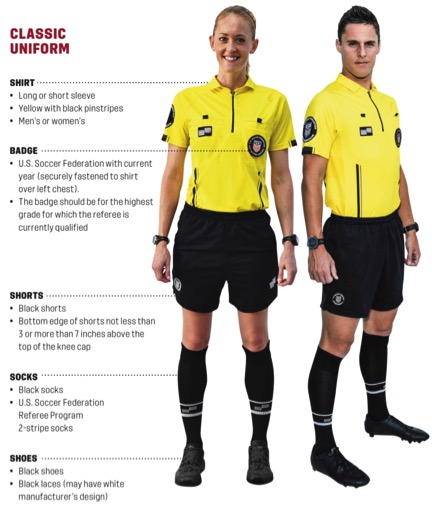The right soccer referee footwear is essential for performance, comfort, and safety. Many ask: What kind of shoes should soccer referees wear? Soccer referees typically wear black athletic shoes, either turf shoes or low-cut cleats, designed for comfort and durability over long periods on the field. This article dives deep into the world of referee shoes for soccer, covering everything from regulations to the best soccer referee shoes on the market.

Image Source: fondysoccer.demosphere-secure.com
Why Proper Footwear Matters for Soccer Referees
Being a soccer referee demands constant movement, sharp turns, and the ability to keep up with the play. Poor footwear can lead to fatigue, injury, and compromised performance. Proper soccer referee footwear provides:
- Support: Reduces strain on feet, ankles, and knees.
- Traction: Prevents slips and falls, especially on wet or uneven surfaces.
- Comfort: Allows referees to focus on the game without distraction from foot pain.
- Professional Appearance: Completes the uniform and conveys authority.
Soccer Referee Shoe Requirements
Official guidelines regarding soccer referee shoe requirements are often broad, leaving room for individual preference within certain boundaries.
- Color: Typically, black soccer referee shoes are the standard. This helps maintain a professional and consistent look with the rest of the uniform. However, some leagues might allow for minimal accent colors. Always check with your specific league or association for clarification.
- Type: Referees generally have a choice between turf shoes and low-cut cleats. The surface they primarily officiate on dictates the best option.
- Material: Shoes should be made from durable and weather-resistant materials. Leather or synthetic leather uppers are common choices.
- Laces: Laces should be black to match the overall soccer referee uniform shoes.
Referee Cleats vs. Turf Shoes
One of the biggest decisions for referees is choosing between referee cleats vs. turf shoes. Both have their advantages depending on the playing surface:
Referee Cleats
Cleats are designed for natural grass fields. They offer superior traction, especially in wet or muddy conditions.
- Pros:
- Excellent grip on grass.
- Better stability during quick movements.
- Suitable for varied field conditions.
- Cons:
- Can be uncomfortable on hard surfaces.
- May cause damage to artificial turf.
- Can wear down quickly if used on the wrong surface.
Turf Shoes
Turf shoes have a flatter sole with small, rubber studs or patterns designed specifically for artificial turf surfaces.
- Pros:
- Comfortable on artificial turf and hard surfaces.
- Provide good traction on turf without causing damage.
- Versatile for different types of surfaces.
- Cons:
- Less effective on natural grass, especially in wet conditions.
- May not provide enough grip for quick changes in direction on grass.
- Can sometimes feel slippery on very muddy surfaces.
Which is Right for You?
Consider these factors when choosing between cleats and turf shoes:
- Playing Surface: Where do you referee most of your games? (Natural grass, artificial turf, or a mix of both)
- Weather Conditions: Do you often referee in wet or muddy conditions?
- Personal Preference: Do you prioritize traction or comfort?
- Level of Competition: Higher levels may require quicker movements and better traction, favoring cleats.
Table: Cleats vs. Turf Shoes for Soccer Referees
| Feature | Cleats | Turf Shoes |
|---|---|---|
| Surface | Natural Grass | Artificial Turf, Hard Surfaces |
| Traction | Excellent | Good |
| Comfort | Lower on Hard Surfaces | Higher |
| Durability | Lower if used on wrong surface | Higher |
| Best For | Wet, muddy grass fields | Dry turf, hard surfaces, mixed conditions |
| Potential Issues | Discomfort on hard surfaces, turf damage | Reduced traction on wet grass |
Factors to Consider When Choosing Soccer Referee Footwear
Beyond the basic requirements, several factors can influence your choice of soccer referee footwear:
Comfort and Fit
Comfortable referee shoes soccer are crucial. You’ll be on your feet for extended periods, so prioritize a shoe that fits well and provides adequate cushioning.
- Arch Support: Consider your arch type (high, low, or neutral) and choose shoes with appropriate support.
- Cushioning: Look for shoes with ample cushioning in the midsole to absorb impact and reduce fatigue.
- Width: Ensure the shoe is wide enough to accommodate your foot without feeling cramped.
- Break-In Period: Some shoes require a break-in period. Wear them for short periods before using them in a game.
Durability
Durable soccer referee shoes are an investment. They should withstand the rigors of regular use and various weather conditions.
- Material Quality: Look for shoes made from high-quality leather or synthetic materials that resist wear and tear.
- Sole Construction: The sole should be securely attached to the upper and resistant to abrasion.
- Stitching: Check for strong, even stitching that won’t unravel easily.
Weather Resistance
Soccer is played in all kinds of weather. Choose shoes that can handle rain, mud, and even extreme temperatures.
- Water Resistance: Look for shoes with water-resistant uppers to keep your feet dry in wet conditions.
- Breathability: Ensure the shoes have adequate ventilation to prevent your feet from overheating in hot weather.
Ankle Support
While referees typically prefer low-cut shoes for mobility, some may benefit from additional ankle support, especially those with a history of ankle injuries.
- Consider shoes with reinforced heel counters or slightly higher collars for added stability.
Best Soccer Referee Shoes: Top Brands and Models
While personal preference plays a role, some brands and models consistently receive high marks from referees:
Adidas
Adidas is a popular choice, offering a range of cleats and turf shoes known for their quality and performance.
- Adidas Copa Mundial: A classic leather cleat known for its comfort and durability.
- Adidas Mundial Team: A turf shoe version of the Copa Mundial, providing similar comfort and performance on artificial turf.
- Adidas Goletto: A more budget-friendly cleat option that still provides good performance.
Nike
Nike is another leading brand, offering innovative designs and technologies.
- Nike Tiempo Legend: A premium leather cleat known for its soft touch and comfortable fit.
- Nike Premier: A more affordable leather cleat that still delivers excellent performance.
- Nike Mercurial: A lightweight cleat designed for speed and agility. (May be flashier than some leagues prefer.)
New Balance
New Balance is known for its focus on fit and comfort, making them a good choice for referees with wide feet or those who prioritize cushioning.
- New Balance Tekela: A cleat designed for touch and control.
- New Balance Audazo: A turf shoe offering excellent comfort and support.
Other Brands
Other brands like Puma, Under Armour, and Diadora also offer quality soccer shoes that may be suitable for referees.
Table: Popular Soccer Referee Shoe Brands and Models
| Brand | Model | Type | Key Features | Ideal For |
|---|---|---|---|---|
| Adidas | Copa Mundial | Cleat | Classic leather, comfortable, durable | Grass fields |
| Adidas | Mundial Team | Turf | Turf version of Copa Mundial | Turf fields |
| Nike | Tiempo Legend | Cleat | Premium leather, soft touch, comfortable | Grass fields |
| Nike | Premier | Cleat | Affordable leather, good performance | Grass fields |
| New Balance | Tekela | Cleat | Touch and control | Grass fields |
| New Balance | Audazo | Turf | Comfortable, supportive | Turf fields |
Finding the Right Fit
Visiting a store that specializes in athletic shoes is highly recommended. Here, you can try on different brands and models to find the best fit. Consider these tips:
- Try on shoes at the end of the day: Your feet tend to swell throughout the day, so trying on shoes later will ensure a more accurate fit.
- Wear soccer socks: Wear the same type of socks you would wear when refereeing to ensure a proper fit.
- Walk and run in the shoes: Test the shoes by walking and running to see how they feel and if they provide adequate support.
- Don’t be afraid to ask for help: Sales associates can provide valuable insights and recommendations based on your needs and preferences.
Maintaining Your Soccer Referee Shoes
Proper care can extend the life of your soccer referee shoes and keep them performing at their best.
- Clean your shoes after each game: Remove dirt, mud, and debris with a brush or damp cloth.
- Air dry your shoes: Allow your shoes to air dry naturally away from direct heat. Stuffing them with newspaper can help absorb moisture and maintain their shape.
- Use shoe trees: Shoe trees help maintain the shape of your shoes and prevent them from creasing.
- Apply leather conditioner: If your shoes are made of leather, apply a leather conditioner regularly to keep the leather soft and supple.
- Replace worn-out cleats or studs: If your cleats or studs become worn or damaged, replace them promptly to maintain traction.
- Store your shoes properly: Store your shoes in a cool, dry place away from direct sunlight.
The Importance of a Professional Appearance
Your soccer referee uniform shoes are part of your overall professional image. A well-maintained uniform, including clean and appropriate footwear, conveys authority and respect.
- First Impressions: A professional appearance can help you establish credibility with players, coaches, and fans.
- League Standards: Adhering to league uniform guidelines demonstrates respect for the game and the association.
Where to Buy Soccer Referee Shoes
You can find official soccer referee shoe brands and various models at:
- Sporting goods stores: Major retailers like Dick’s Sporting Goods and Academy Sports + Outdoors carry a wide selection of soccer shoes.
- Specialty soccer stores: These stores offer a more curated selection of soccer-specific footwear and equipment.
- Online retailers: Online retailers like Amazon, Soccer.com, and World Soccer Shop offer a vast selection of soccer shoes with the convenience of online shopping.
Frequently Asked Questions (FAQ)
-
What is the standard color for soccer referee shoes?
The standard color is black. This helps maintain a professional appearance.
-
Can I wear running shoes as a soccer referee?
While you can, it’s not recommended. Running shoes lack the necessary traction and support for the demands of refereeing. Turf shoes or low-cut cleats are much better options.
-
Who is responsible for enforcing shoe requirements?
The league or association you are officiating for is responsible. Typically, assignors or referee mentors will check uniforms.
-
Can I wear white-soled shoes as a referee?
Generally, no. Most leagues require all-black shoes or shoes with minimal accent colors. Check your specific league guidelines.
-
What if I have a foot condition that requires special shoes?
Consult with your doctor or podiatrist to find shoes that meet your specific needs. You may need to request an exception from your league.
-
Are there specific shoes for female soccer referees?
While some brands offer women’s-specific soccer shoes, many referees find that men’s or unisex models work just as well. The key is finding a shoe that fits comfortably and provides adequate support.
-
How often should I replace my referee shoes?
It depends on how often you referee and the conditions you play in. As a general rule, replace your shoes when they show signs of wear and tear, such as worn soles, damaged uppers, or loss of cushioning. Aim to replace them every one to two years with regular use.
Choosing the right soccer referee footwear is crucial for your comfort, performance, and safety on the field. By considering the factors outlined in this guide and exploring the available options, you can find the perfect pair of shoes to help you officiate with confidence.

David Ruperto is a Footwear Engineer with expertise in 3D printing, design, and pattern making. With a background in Fine Arts from CUNY and training from SLEM and Cordwainer’s Savannah, he blends creativity with innovation. Based in New York, he shares his knowledge on BestForShoes.com, helping others explore the world of footwear.
